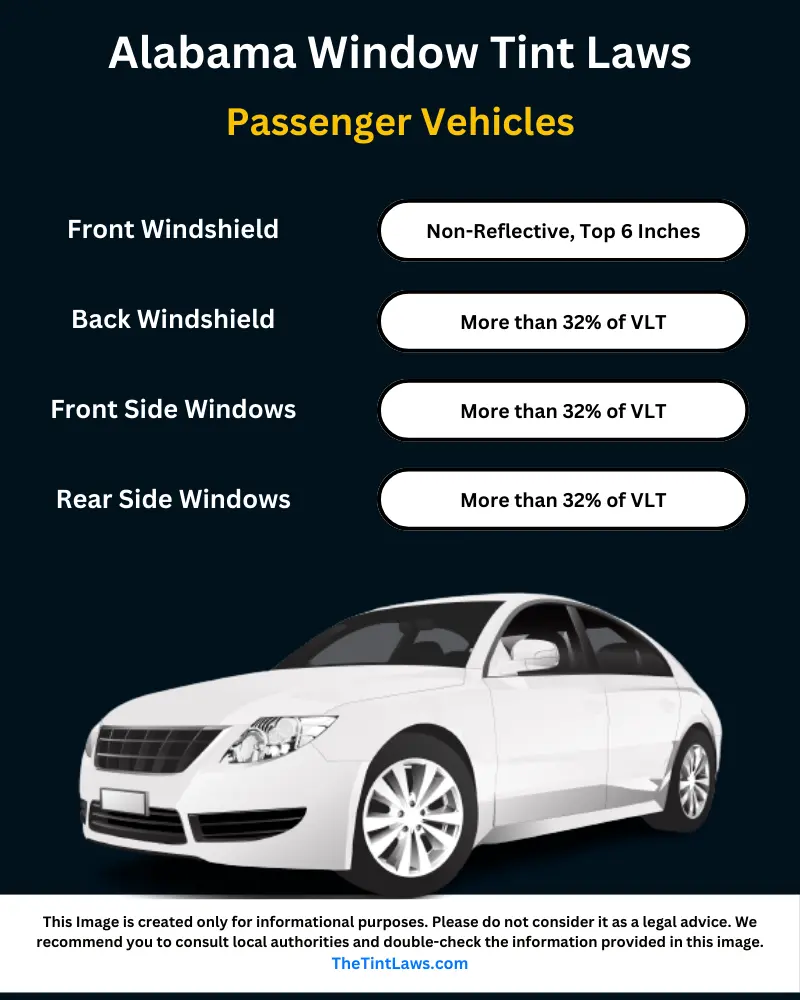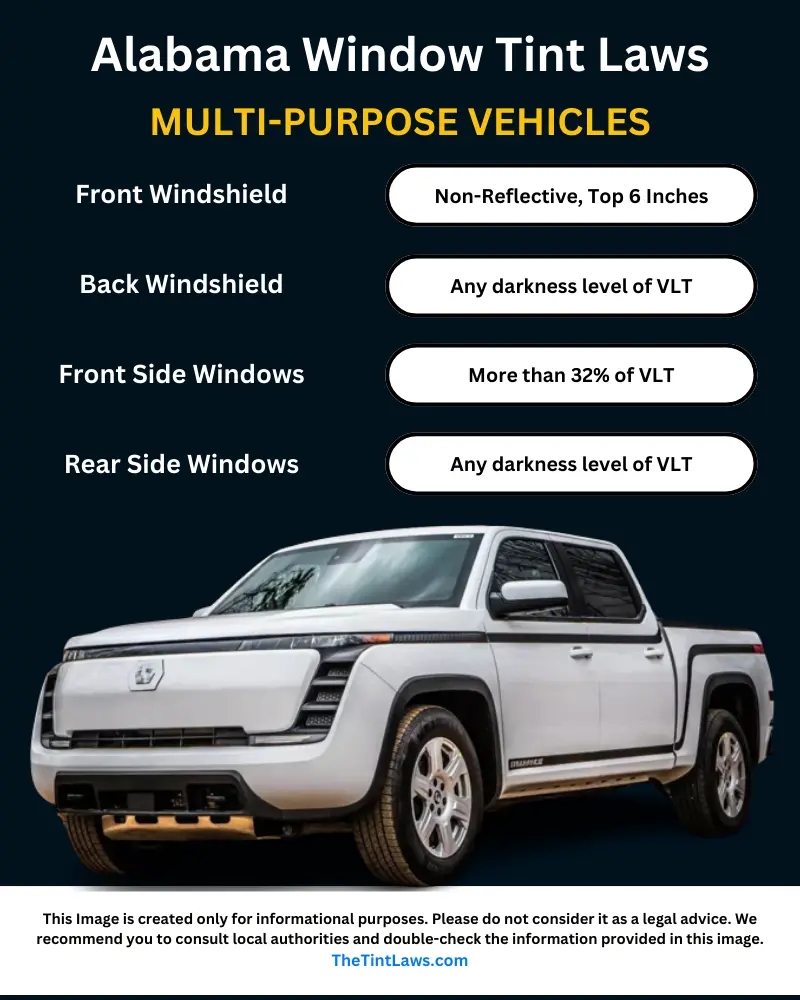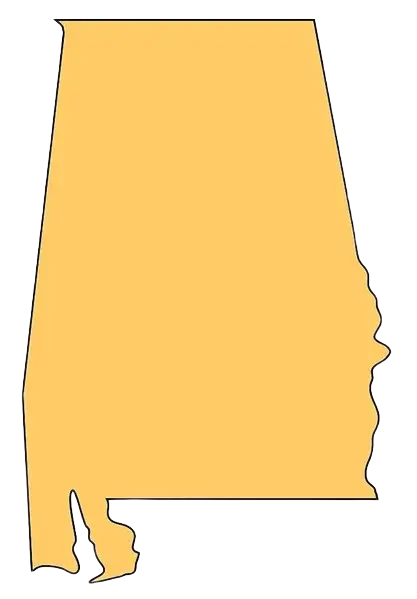Cruising down the sunny streets of Alabama with the windows down is a great way to enjoy the ride. But if you’re looking for more privacy and protection from the sun’s glare, window tinting can be a tempting option. Before you get your windows tinted, it’s important to understand Alabama tint laws.
These regulations are in place to ensure driver visibility and safety and unknowingly violating them can lead to fines and even having to remove your tint. Let’s delve into the specifics of Alabama’s tint laws and what you need to know for a legal and comfortable ride.
Alabama window tint laws were enacted in 1996. The darkest legal tint in Alabama is 32% of VLT for all windows except the windshield according to the window tint laws in Alabama State.
How tint percentage is measured by the Alabama Tint Laws?
Tint darkness level is measured by Visible Light Transmission (VLT), which indicates the percentage of light that passes through the film. Here’s a breakdown of the legal VLT limits for different types of vehicles.
Legal tint darkness for sedans:
- Windshield: Only non-reflective tint is allowed on the top 6 inches.
- Front side windows: More than 32% of VLT should be allowed.
- Back side windows: More than 32% of VLT should be allowed.
- Rear window: More than 32% of VLT should be allowed.

Legal tint darkness for SUV and Van:
- Windshield: Only non-reflective tint is allowed on the top 6 inches.
- Front side windows: More than 32% of VLT should be allowed.
- Back side windows: Any darkness level is permitted.
- Rear window: Any darkness level is permitted.

Important Note: It’s crucial to remember that these are the minimum VLT requirements. You can have a lighter tint (higher VLT percentage) as long as it meets the legal limit. However, anything darker than the specified VLT is considered illegal.
Window tint reflection in Alabama:
Car window tinting laws in Alabama state allow a certain percentage of tint reflection for all types of vehicles.
Tint Reflection for sedans:
- Front Side windows: It should not be more than 20% reflective.
- Back Side windows: It should not be more than 20% reflective.
Tint Reflection for SUV and Van:
- Front Side windows: It should not be more than 20% reflective.
- Back Side windows: It should not be more than 20% reflective.
Alabama Window Tinting Rules and Regulations:
- Side mirrors: Both side mirrors are required in case of a tinted rear window.
- Restricted Colors: There is no restriction about using any tint color by the Alabama window tinting laws.
- Certificates: Film manufacturers must certify the films they sell in the state. Ensure your tint installer is using certified film only.
- Stickers: Alabama tint laws require a sticker indicating that the tint complies with car tinting laws (Section 32-5C-6).
- Tint Variance: A 3% tint variance is allowed for front-side windows and read-side windows.
- Medical tint exemptions: A doctor’s written statement may allow exceptions to the tint darkness requirements for medical reasons (Section 32-5C-4).
Alabama Tint Ticket Cost:
In Alabama, having a window tint that doesn’t follow the state’s rules is a misdemeanor (Section 32-5C-7). Also in some counties window tint tickets vary.
- First offense: Up to $100 fine or up to 10 days in jail or both.
- Second offense (within a year): Up to $200 fine or up to 30 days in jail or both.
- Third or more offense (within a year): Up to $500 fine or up to 3 months in jail or both.
Tint Laws Reference: 2023 Code of Alabama, Title 32-5C Window Tinting. | Alabama Tinting Regulations
Information about Alabama State
Alabama is a state located in the southeastern region of the United States. Alabama is bordered by Tennessee to the north, Georgia to the east, Florida and the Gulf of Mexico to the south, and Mississippi to the west.
Alabama is the 30th largest US state by land area and the 24th most populous state in the USA. The largest city in Alabama State is Huntsville.

Capital
Montgomery
Population
5,108,468 (2023)
Area
50,633 mi2 (135,767 km2)
Cities in Alabama State
Huntsville, Birmingham, Montgomery, Mobile, Tuscaloosa, Hoover, Auburn, Dothan, Madison, Decatur, Florence, Prattville, Phenix City, Vestavia Hills, Alabaster, Opelika, Gadsden, Northport, Athens, Daphne, Enterprise, Homewood, Trussville, Pelham, Bessemer, Fairhope, Foley, Albertville, Helena, Oxford, Mountain Brook, Anniston, Cullman, Prichard, Calera, Tillmans Corner, Troy, Millbrook, Muscle Shoals, Gulf Shores, Chelsea, Selma, Saraland, Hueytown, Gardendale, Hartselle, Scottsboro, Center Point, Fort Payne, Talladega, Jacksonville, McCalla, Alexander City, Jasper, Ozark, Pell City, Moody, Irondale, Eufaula, Leeds, Sylacauga, Pike Road, Spanish Fort, Russellville, Saks, Boaz, Rainbow City.
Counties in Alabama State
The State of Alabama is divided into 67 counties.
Autauga, Baldwin, Barbour, Bibb, Blount, Bullock, Butler, Calhoun, Chambers, Cherokee, Chilton, Choctaw, Clarke, Clay, Cleburne, Coffee, Colbert, Conecuh, Coosa, Covington, Crenshaw, Cullman, Dale, Dallas, DeKalb, Elmore, Escambia, Etowah, Fayette, Franklin, Geneva, Greene, Hale, Henry, Houston, Jackson, Jefferson, Lamar, Lauderdale, Lawrence, Lee, Limestone, Lowndes, Macon, Madison, Marengo, Marion, Marshall, Mobile, Monroe, Montgomery, Morgan, Perry, Pickens, Pike, Randolph, Russell, Saint Clair, Shelby, Sumter, Talladega, Tallapoosa, Tuscaloosa, Walker, Washington, Wilcox, and Winston.